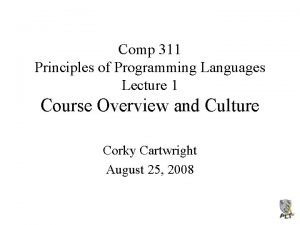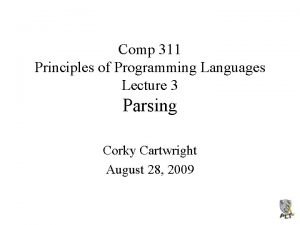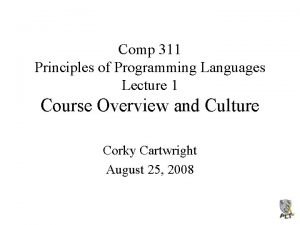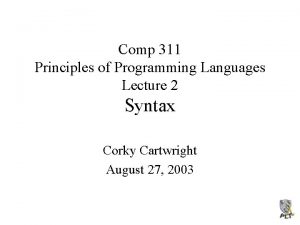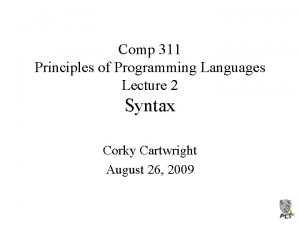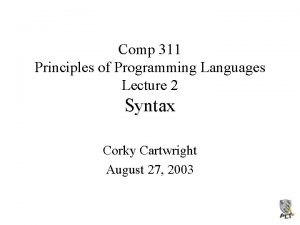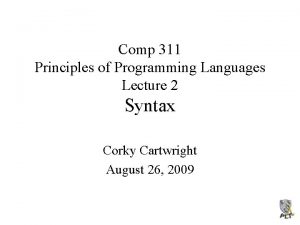Comp 311 Principles of Programming Languages Lecture 4


![Some scoping examples • Java: class Foo { static void do. Nothing() { int[] Some scoping examples • Java: class Foo { static void do. Nothing() { int[]](https://slidetodoc.com/presentation_image_h/2a868ceac40d2f9634629bd17b6b02e3/image-3.jpg)





- Slides: 8

Comp 311 Principles of Programming Languages Lecture 4 The Scope of Variables Corky Cartwright September 3, 2008

Variables • What is a variable? A legal symbol without a pre-defined (reserved) meaning that can be bound to a value (and perhaps rebound to a different value) during program execution. – Examples in Scheme/Java x y z – Non-examples in Java + null true false 7 f – Complication in Java: variables vs. fields • What happens when the same name is used for more than one variable? – Example in Scheme: (lambda (x) (x (lambda (x) x))) We use scoping rules to distinguish them.
![Some scoping examples Java class Foo static void do Nothing int Some scoping examples • Java: class Foo { static void do. Nothing() { int[]](https://slidetodoc.com/presentation_image_h/2a868ceac40d2f9634629bd17b6b02e3/image-3.jpg)
Some scoping examples • Java: class Foo { static void do. Nothing() { int[] a =. . . ; for int i = 0; i < a. length; i++) {. . . }. . . // <is a in scope here? } is i in scope here? > . . . } What is the scope (part of the program where it can be accessed/referenced) of a? What is the scope of i?

Formalizing Scope • Focus on language LC (from last lecture). Recall that LC is the language generated by the root symbol Exp in the following grammar Exp : : = Num | Var | (Exp Exp) | (lambda Var Exp) where Var is the set of alphanumeric identifiers excluding lambda and is the set of integers written in conventional decimal radix notation. • If we interpret LC as a sub-language of Scheme, it contains only one binding construct: lambda-expressions. In (lambda (a-variable) an-expression) � a-variable is introduced as a new, unique variable whose scope is the body an-expression of the lambda-expression (with the exception of possible "holes", which we describe in a moment).

Free and Bound Occurrences • An important building block in characterizing the scope of variables is defining when a variable i occurs free in an expresssion. For LC, this notion is easy to define inductively. • Definition (Free occurrence of a variable in LC): Let x, y range over the elements of Var. Let M, N range over the elements of Exp. Then x occurs free in: – y if x = y; – (lambda (y) M) if x != y and x occurs free in – (M N) if it occurs free either in M or in N. The relation x occurs free in y is the least relation on LC expressions satisfying the preceding constraints. • Definition: x occurs bound in M iff x does not occur free in M. • It is straightforward but tedious to define when a particular occurrence of a variable x (identified by a path of tree selectors) is free or bound; the definition proceeds along similar lines to the definition of occurs free given above.

Static Distance Representation • The choice of bound variable names in an expression is arbitrary (modulo ensuring distinct, potentially conflicting variables have distinct names). • We can eliminate explicit variable names by using the notion of “relative addressing”: a variable reference simply has to identify which lambda abstraction introduces the variables to which it refers. We can number the lambda abstractions enclosing a variable occurrence 1, 2, . . . and simply use these indices instead of variable names. Since LC includes integer constants, we will embolden the indices referring to variables to distinguish them from integer constants. • Examples: – (lambda (x) x) ---> (lambda 1) – (lambda (x) (lambda (y) (lambda (z) ((xz)(yz))))) ---> (lambda ((3 1)(2 1)))))

A Simple Example Exp : : = Num | Var | (Exp Exp) | (lambda Var Exp) Num is the set of numeric constants (given in the lexer spec) Var is the set of variable names (given in the lexer spec) • To represent this syntax as trees (abstract syntax) in Scheme ; exp : = (make-num number) + (make-var symbol) + (make-app exp) + ; (make-proc symbol exp) (define-struct (num n)) (define-struct (var s)) (define-struct (app rator rand)) (define-struct (proc param body)) ; ; param is a symbol not a var! • app represents a function application • proc represents a function definition

Top Down (Predictive) Parsing Idea: design the grammar so that we can always tell what rule to use next starting from the root of the parse tree by looking ahead some small number of token (LL(k) parsing). Can easily be implemented by hand: called recursive descent. Conceptual aid: syntax diagrams.
